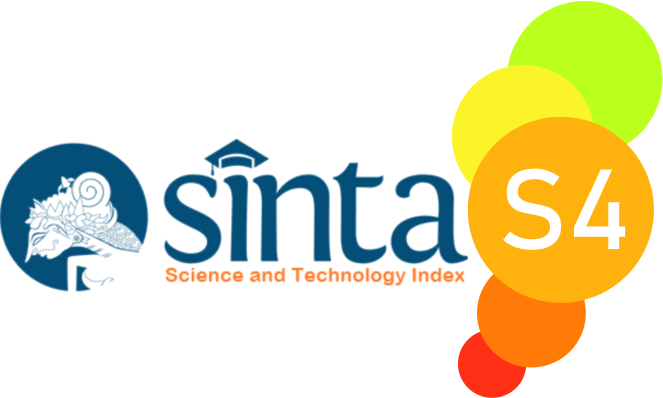An Analysis of Students’ Low Confidence in Speaking, As the Attribute of Pronunciation Context
Abstract
Speaking requires mastering the vocabulary and pronunciation of the language well. The objective of this study is to find out the causes of students’ error in pronunciation and the students’ treatment in controlling their low confidence in speaking, to know the significant reasons of the phenomenon occurs. It is significantly influencing the developing of self-confidence and fluency in English. A mixed-methods approach used as research design. The subject of this research is students of English department who has problem in speaking. The data showed that students’ low confidence was caused by the problem of pronunciation. The biggest factor of students’ error in pronunciation is lack of practice and low motivation. The students had challenged about finding friends who can directly speak English. Another aspect also touches about the surrounding environment uses regional languages and speaks Indonesian who prevent them to practice English. This study proved that low quality in English pronunciation caused low in English Speaking Competency. The study found some causes of students’ errors in English pronunciation, namely; Phonological Interference from Native Language, Lack of Exposure to Native English, Insufficient Pronunciation Practice, Teaching Methods and Materials, Psychological Factors.
References
Anderson, C., & etall. (2018). A cross-linguistic database of phonetic transcription systems. Yearbook of Poznan Linguistic Meeting 4, 21–53. https://doi.org/10.2478/yplm-2018-0002
Annisa, A., & Wariyati, W. (2023). Speaking Challenge, Does Pronunciation as the Attribute of Fluency? Journey: Journal of English Language and Pedagogy, 6(2), 356–365.
Armasita, F. (2019). Foreign language testing: a practical approach to language teaching.San. Prentice.
Astuti, P., & Lammers, J. (2021). Personal responsibility in cooperative learning: More opportunities to speak English. Indonesian Journal of Applied Linguistics, 7(1), 215–228.
Brown, D., & H. (2001). Principles of Language Learning and Teaching. Prentice Hall Inc.
Gilakjani, A., Ahmadi, S., Adhmadi, M., & M. (2017). Why is Pronunciation So.
Imran, F. (2018). Penelitian Experiment.Unpublished. IKIP Mataram.
Indrila, N. (2018). The effectiveness of scientific and contextual approaches in teaching and learning writing. Lingua Cultura, 12(4), 405–41.
Juita, E. (2021). Speaking Assessment for Students of Medical Laboratory Technology. Journey (Journal of English Language and Pedagogy), 4(1), 1–10. https://doi.org/10.33503/journey.v4i1.1227
Leong, L. M., & Ahmad, S. M. (2017). An Analysis of Factors Influencing Learners’ English Speaking Skill. International Journal of Research in English Education.
Megawati, F. (2019). Ways For Tertiary Level Students In Building English Speaking Performance. Journal of Linguistic and English Teaching, 137–144.
Putra, I. N. T. D. (2021). Analysis of students’ability in using english for taking order procedure in restaurant. Jo-ELT (Journal of English Language Teaching) Fakultas Pendidikan Bahasa & Seni Prodi Pendidikan Bahasa Inggris IKIP, 5(1), 12–20.
R, M. Bk. (2011). Cooperative Learning Effectiveness with Undergraduate Hispanic Students (B. M. Morgan & E. D (eds.)).
Rukmini, S. (2021). Authentic assessment to measure students’ effective English skills based on the 2013 curriculum. Indonesian Journal of Applied, tics,7(2), 263–273.
Setiyono, M. S. (2019). Using international phonetic alphabet (IPA) in teaching pronunciation: linguistics in present century. International Journal of English Linguistics, Literature, and Education (IJELLE, 1(1), 25–30.
Silalahi, R. M. (2017). Assessing college students’ critical thinking skills using the TOEFL ITP reading test. Language Culture, 11(2), 79.
Summary., B., & Arraffi. (2018). Students’ needs in developing written materials in English. Cultural Language, 11(2).
Sundari, H., & Dasmo. (2022). The effect of speaking self-efficacy and gender in speaking activities. Bahasa and Sastra, 14(2), 205–2017.
Wariyati, W., Fadlan, M. N., Khalid, M., & Tambusai, A. (2020). Overcoming Speaking Barrier. Journey: Journal of English Language and Pedagogy, 6(3), 713–720.
Copyright (c) 2024 Karmida Karmida, Wariyati Wariyati, Ahmad Laud Hasibuan, Nurlaili Nurlaili

This work is licensed under a Creative Commons Attribution-ShareAlike 4.0 International License.

Journey: Journal of English Language and Pedagogy by http://ejurnal.budiutomomalang.ac.id/index.php/journey/index is licensed under a Creative Commons Attribution-ShareAlike 4.0 International License.






